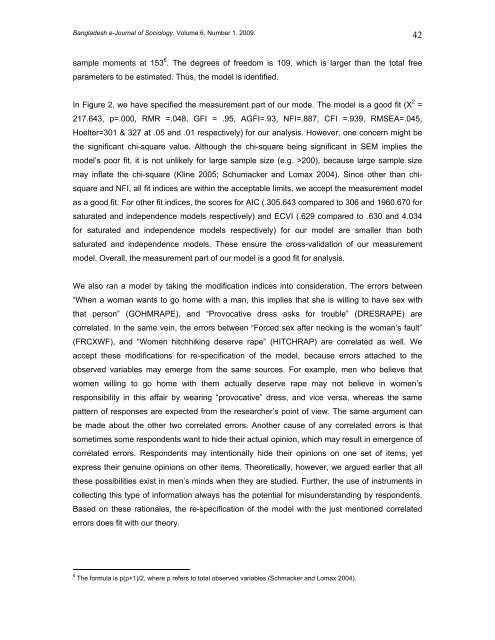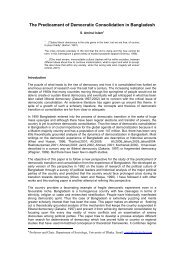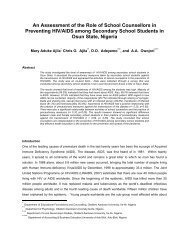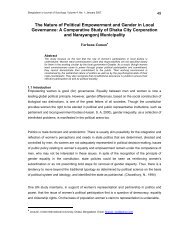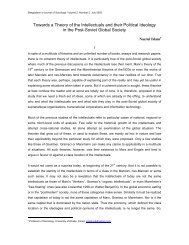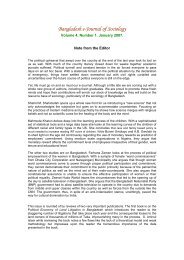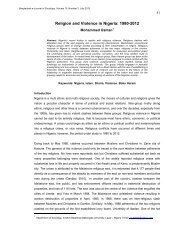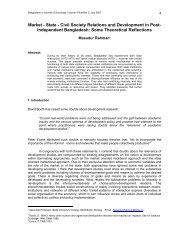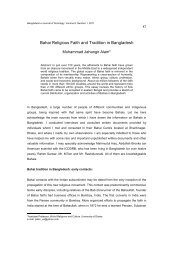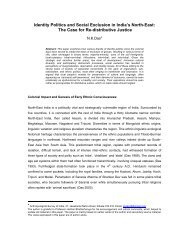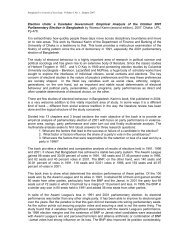Bangladesh e-Journal of Sociology - Bangladeshsociology.org
Bangladesh e-Journal of Sociology - Bangladeshsociology.org
Bangladesh e-Journal of Sociology - Bangladeshsociology.org
Create successful ePaper yourself
Turn your PDF publications into a flip-book with our unique Google optimized e-Paper software.
<strong>Bangladesh</strong> e-<strong>Journal</strong> <strong>of</strong> <strong>Sociology</strong>. Volume 6, Number 1. 2009.<br />
42<br />
sample moments at 153 6 . The degrees <strong>of</strong> freedom is 109, which is larger than the total free<br />
parameters to be estimated. Thus, the model is identified.<br />
In Figure 2, we have specified the measurement part <strong>of</strong> our mode. The model is a good fit (X 2 =<br />
217.643, p=.000, RMR =.048, GFI = .95, AGFI=.93, NFI=.887, CFI =.939, RMSEA=.045,<br />
Hoelter=301 & 327 at .05 and .01 respectively) for our analysis. However, one concern might be<br />
the significant chi-square value. Although the chi-square being significant in SEM implies the<br />
model’s poor fit, it is not unlikely for large sample size (e.g. >200), because large sample size<br />
may inflate the chi-square (Kline 2005; Schumacker and Lomax 2004). Since other than chisquare<br />
and NFI, all fit indices are within the acceptable limits, we accept the measurement model<br />
as a good fit. For other fit indices, the scores for AIC (.305.643 compared to 306 and 1960.670 for<br />
saturated and independence models respectively) and ECVI (.629 compared to .630 and 4.034<br />
for saturated and independence models respectively) for our model are smaller than both<br />
saturated and independence models. These ensure the cross-validation <strong>of</strong> our measurement<br />
model. Overall, the measurement part <strong>of</strong> our model is a good fit for analysis.<br />
We also ran a model by taking the modification indices into consideration. The errors between<br />
“When a woman wants to go home with a man, this implies that she is willing to have sex with<br />
that person” (GOHMRAPE), and “Provocative dress asks for trouble” (DRESRAPE) are<br />
correlated. In the same vein, the errors between “Forced sex after necking is the woman’s fault”<br />
(FRCXWF), and “Women hitchhiking deserve rape” (HITCHRAP) are correlated as well. We<br />
accept these modifications for re-specification <strong>of</strong> the model, because errors attached to the<br />
observed variables may emerge from the same sources. For example, men who believe that<br />
women willing to go home with them actually deserve rape may not believe in women’s<br />
responsibility in this affair by wearing “provocative” dress, and vice versa, whereas the same<br />
pattern <strong>of</strong> responses are expected from the researcher’s point <strong>of</strong> view. The same argument can<br />
be made about the other two correlated errors. Another cause <strong>of</strong> any correlated errors is that<br />
sometimes some respondents want to hide their actual opinion, which may result in emergence <strong>of</strong><br />
correlated errors. Respondents may intentionally hide their opinions on one set <strong>of</strong> items, yet<br />
express their genuine opinions on other items. Theoretically, however, we argued earlier that all<br />
these possibilities exist in men’s minds when they are studied. Further, the use <strong>of</strong> instruments in<br />
collecting this type <strong>of</strong> information always has the potential for misunderstanding by respondents.<br />
Based on these rationales, the re-specification <strong>of</strong> the model with the just mentioned correlated<br />
errors does fit with our theory.<br />
6<br />
The formula is p(p+1)/2, where p refers to total observed variables (Schmacker and Lomax 2004).


